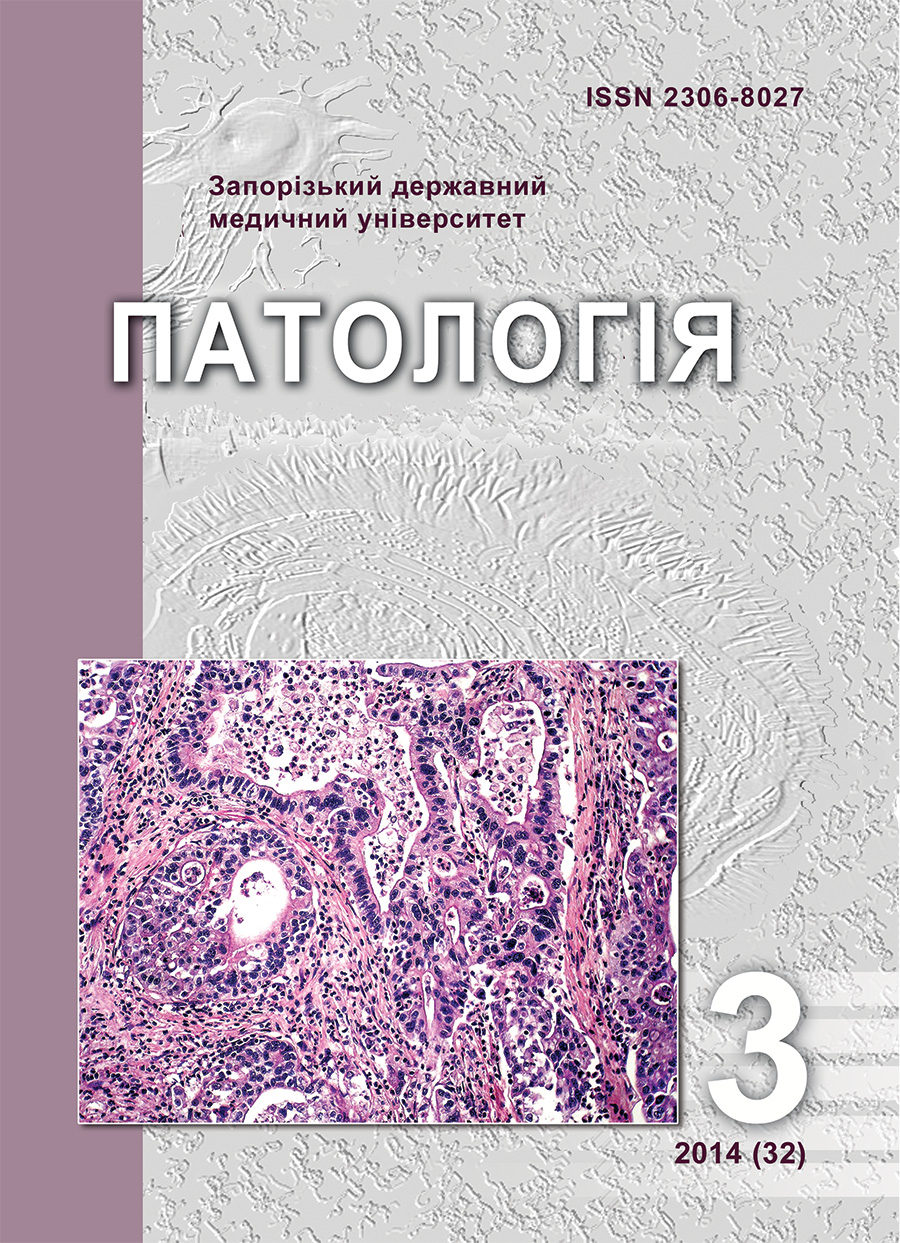Comparative estimation of ErbB family growth receptors, Ki-67 and E-cadherin expression in pancreatic ductal adenocarcinoma cells
DOI:
https://doi.org/10.14739/2310-1237.2014.3.36841Keywords:
Pancreatic Cancer, Growth Factor ReceptorsAbstract
Aim. In immunohistochemical research of biopsy and postoperative material of 120 patients with the pancreatic ductal adenocarcinoma the levels of growth receptors of ErbB family and cancer prognostic markers expression were determined.
Methods and results. Positive expression of EGFR by the tumour cells is determined in 87,5% of patients with ductal adenocarcinoma, simultaneously 77,5% of such patients had negative, and 13,33% of patients – doubtful HER-status. Expression of Ki-67 inductal carcinoma cells was found in 74,17% of patients, there were distinctions in expression of this marker within one tumour. The decline of expression of Е-cadherin was marked in 28,33% of patients with ductal adenocarcinoma, it was significantly more expressed in the areas of tumour invasion into the wall of duodenum.
Conclusion. In patients with ductal adenocarcinoma direct correlation of medium strength between the levels of EGFR and HER-2/neu, EGFR and Кі-67, Кі-67 and HER-2/neu expression by the tumour cells is marked, inverse strong correlation between the level of EGFR and Е-cadherin expression, inverse correlation of medium strength between the level of expression of HER-2/neu and Е-cadherin, and between the level of Кі-67 and Е-cadherin expression there is weak inverse correlation.
References
Bruckner, H. W., Hrecorovich, V. R., & Sawhney, H. S. (2005). Bevacizumab as treatment for chemotherapy-resistant pancreatic cancer. Anticancer Res., 25, 3637–3639.
Chetty, R., & Serra, S. (2008). Nuclear E-cadherin immunoexpression: from biology to potential applications in diagnostic pathology. Adv. Anat. Pathol., 15, 234–240.
Dabbs, D. J. (2010). Diagnostic Immunohistochemistry (3rd ed.). New York: Ch. Livingstone.
Laudadio, J., Quigley, D. I., Tubbs, R., & Wolff, D. J. (2007). HER2 testing: a review of detection methodologies and their clinical performance. Expert Rev. Mol. Diagn., 7(1), 53–64.
Tsiambas, E., Karameris, A., Dervenis, C., Lazaris, A.C., Giannakou, N., Gerontopoulos, K., & Patsouris, E. (2006). HER2/neu expression and gene alterations in pancreatic ductal adenocarcinoma: a comparative immunohistochemistry and chromogenic in situ hybridization study based on tissue microarrays and computerized image analysis. Journal Of Pancreas, 7(3), 283–294.
Oliveira-Cunha, M., Newman, W. G., & Siriwardena, A. K. (2011). Epidermal growth factor receptor in pancreatic cancer. Cancers, 3, 1513–1526.
Neoptolemos, J. P., Urrutia, R., Abbruzzese, J. L., & Büchler, M. W. (eds.). (2010). Pancreatic Cancer. Springer Science+Business Media, LLC.
Ménard, S., Casalini, P., Campiglio, M., Pupa, S.M., & Tagliabue, E. (2005). Role of HER2/neu in tumor progression and therapy. Cell. Mol. Life Sci., 2005, 61(23), 2965–2978.
Klöppel, G., Hruban, R.H., Longnecker, D.S., et al. (2000) Tumours of the exocrine pancreas. Hamilton, S., Aaltonen, L.A. (eds.). World Health Organization Classification of Tumours-Pathology and Genetics of Tumours of the Digestive System. (p. 219–305). Lyon: IARC Press.
Downloads
How to Cite
Issue
Section
License
Authors who publish with this journal agree to the following terms:
Authors retain copyright and grant the journal right of first publication with the work simultaneously licensed under a Creative Commons Attribution License that allows others to share the work with an acknowledgement of the work's authorship and initial publication in this journal.

Authors are able to enter into separate, additional contractual arrangements for the non-exclusive distribution of the journal's published version of the work (e.g., post it to an institutional repository or publish it in a book), with an acknowledgement of its initial publication in this journal.
Authors are permitted and encouraged to post their work online (e.g., in institutional repositories or on their website) prior to and during the submission process, as it can lead to productive exchanges, as well as earlier and greater citation of published work (SeeThe Effect of Open Access).

